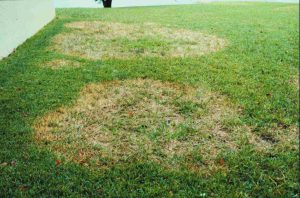There are many reasons why warm season lawns in Central Florida may have dead or dying areas. These problem areas can result from not only insect or disease pressure, but also from cultural problems including irrigation, fertilization or mowing practices. Large Patch is a fungal problem that can affect all warm season lawns as the weather cools .
When to find Large Patch

Large Patch or Brown Patch (Rhizoctonia) can be problem in warm season lawns from November to May when temperatures drop below 80 degrees F. Patches range in color as the fungus progresses from yellow to reddish brown to brown or straw-colored. The rotted leaves can easily be pulled up and may smell. The patches are outlined by a darkened area on the outside edge and sometimes green grass may come back in the middle of the brown area. It may be harder to identify when warm season lawns are dormant. However, the darker colored halo may be seen on the outside rim even in dormant, tan lawns. Brown Patch is a problem in other seasons too. Infection can develop in lawns that are wet for at least 48 hours Excessive irrigation, rain or high humidity can set the stage for Brown Patch.
Cultural Care
Maintaining a healthy lawn can lead to a reduced infection of brown patch by watering efficiently and fertilizing appropriately. Plan to irrigate from 2 am to 7 am which is the time of typical dew fall. Irrigate 1/2 inch to 3/4 inch per irrigation up to two times a week during the growing season, and do not water more than two times per week. You may choose to water one time per week during the cooler season, and may “skip a week” from December to February. Your lawn will be dormant and will only need water every 10-14 days.
A slow release fertilizer should be applied to your lawn only during the growing season. Use only up to to 2.5 pounds of Nitrogen annually applying no more than 1 pound of Nitrogen/1000 square feet per application. Your warm season lawn does not require any fertilizer from October through the end of March. To prevent infection, lawnmowers should be cleaned between clients as the Large Patch can be spread from lawn to lawn.
Treatment
Fungicides can be used to treat lawns that have shown Brown Patch now or in the past. Fungicides do not promote active turf growth, and your turf should be actively growing for it to recover which will happen after the dormant season. Contact your Extension Office for more information on specific products.
Visit https://edis.ifas.ufl.edu/topic_large_patch.to read more about how this fungus could affect your lawn.
 2
2
